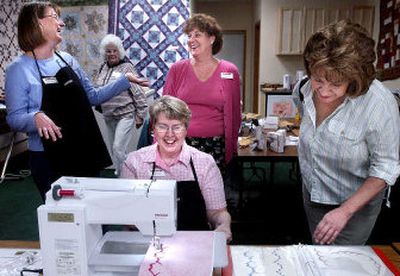Quilting is a marriage of beauty and function

David Parker, an accountant at North Idaho College, and, more importantly, an avid quilter, recalls a particularly grueling day at work when, on his way out the door, his boss asked him if he’d be all right. David replied with a sigh, “I’ll be OK. I’m heading to the quilt shop to buy some fabric.”
There are times when a half-yard of a new Hoffman batik really hits the spot.
As a male quilter, Parker is in the minority, but he’s joined by more than 21 million female counterparts. According to Quilts.com, the number of quilters in the country has increased by 1.55 million in the past three years, and the growth of Coeur d’Alene’s Bear Paw Quilting and Bernina mirrors the national trend.
The shop, located in the Sunset Mall on U.S. Highway 95, officially opened in October 2002, in 1,800 square feet of space and with 1,000 bolts of fabric. By May 2003, the shop, co-owned by Sandy Goedde and Kathryn Boss, had doubled in size and inventory. And just this month, it tripled in size with completion of a third phase of expansion. The growth has been in response to both polite customer requests and hysterical, addictive demand.
Truly powerful hobbies have high addiction potential, and the best obsessions include countless opportunities to buy hobby-related paraphernalia. Quilting fits the bill well. Besides fabric and sewing machines, quilters buy tools, accessories, books, magazines, patterns, kits, notions, even quilt-related jewelry and stationery.
At the check-out counter, Goedde and Boss have sturdy, clear plastic bags with the Bear Paw logo printed on them, but they are often asked to load the goods into plain brown paper bags, “so my husband won’t know I’ve been here again.”
Why is quilting so appealing? The marriage of beauty and function is a winning formula, and quilts exemplify this combination, Boss explains.
“The term ‘quilting’ means something sewn together in three layers: a top, a backing and something for warmth in between,” she says. “In Asia and Europe it took the form of clothing and decorative tapestries, but in America, quilting became synonymous with blankets – from the necessity of warmth. The traditional patterns of early American quilting still hold great appeal, but changes in color and design keep quilters excited. So the appeal is two-fold: a tie to historical roots and a creative artistic outlet.”
Goedde adds, “After doing battle in this techno, too-fast world, quilting is an easily accessible art form, and a wonderful way to relax and to leave a legacy. In addition to quilting, we’re seeing the resurgence of age-old crafts and activities such as farmers’ markets, gardening and knitting.”
Boss has been teaching quilting classes for eight years. “When women ask me what I do, I can’t tell you how many of them say, ‘I’ve always wanted to learn to quilt.’ Not everyone wants to sew, but quilt-making has appeal. It was different when I was teaching Lamaze classes. I didn’t often hear, ‘Oh, I’ve always wanted to learn to breathe!’ Breathing is basic, but quilting is a basic calling.”
Karolyne Rogers, a local psychologist, says that women have a need to be of service. So even when quilting reaches pathological obsession level, it’s culturally justifiable since the end result is a blanket, which answers a basic human need for warmth.
Sheryl Wytychak, a classic “dedicated quilter,” stresses that quilting provides connection to other women who share a common interest, is a source of genuine pleasure, and is an opportunity to express herself through color, texture, and design.
The profile of the modern-day “dedicated quilter” might come as a surprise. The average quilter, according to an August 2003 study by NFO and Abacus Custom Research Inc., is a 58-year-old female, is well-educated (76 percent have attended college), affluent, with a household income of $80,000 who has been quilting for an average of 12 years. She spends $1,900 a year on quilting, owns an average of two sewing machines and $5,500 worth of quilting supplies and tools, and has $2,800 worth of fabric in her “stash.” She is an empty-nester looking forward to retirement, with disposable income and discretionary time on her hands.
This is not your great-grandma’s sewing circle meeting in the basement of the Presbyterian church. The baby boomers, demographic family of the modern-day quilter, were the last group of women to attend home economics classes in junior high school. These women know how to sew and are now reaching into their collective past to draw on those latent talents.
According to the NFO/Abacus study, dedicated quilters spent a total of $2.15 billion on quilting supplies in 2003, up 26 percent from the report in the year 2000. This is roughly twice the annual Idaho state budget. The total number of quilters in the U.S. exceeds 21 million, a 50 percent increase from 14 million reported in 1997. And these are known quilters. One can only guess what adding suspected and closet quilters would do to the figures.
A cartoon at the Bear Paw shop shows a man dozing in a lounge chair next to a sewing machine, with two women standing beside him. One woman is saying, “Apparently your husband is into quilting, too.” The other replies, “Oh, he has no idea how far into quilting he is!”